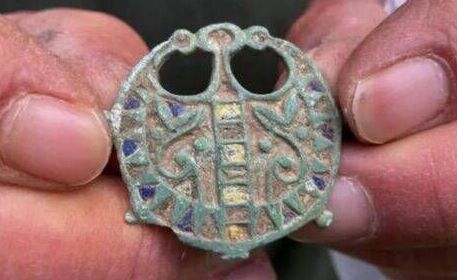A metal detecting enthusiast in Puddletown, Dorset, has unearthed a rare brooch dating back approximately 2,000 years, initially mistaking it for a children’s toy. Martin Turner discovered the artifact while exploring fields near his home. Upon cleaning the item, he noticed signs of “bronze disease,” indicating its age and historical significance.
Turner later presented his find to a local finds liaison officer, who confirmed the brooch’s importance and plans to record it formally. Should no rightful owner claim the artifact, it will likely be returned to Turner, who has expressed interest in donating it to a nearby museum. This discovery adds to the excitement surrounding historical finds, reminiscent of a recent episode of the Antiques Roadshow, where a guest learned her heirloom wedding necklace was valued at over $10,000.
Significance of the Discovery
The brooch, estimated to have originated between the 1st century BC and the 1st century AD, falls within the late Iron Age, a period marked by the early Roman invasion of Britain. Such artifacts provide valuable insights into the cultural and historical context of the time.
Turner and his son began metal detecting as a hobby three years ago after moving to the area. Since then, they have discovered hundreds of items, with Turner using a secondhand metal detector he purchased for approximately £600. He stated, “Every field I go in, I find stuff. I must have 13 Chinese tubs full of antiquities.”
Turner highlighted one of their most remarkable finds: 14 Bronze Age heads, which he described as “unreal.” These were donated to the British Museum in London. Reflecting on the experience, he remarked, “People spend all their lives trying to get one of these on their bucket list, and I’ve been part of finding 14 of them. The feeling of holding them for the first time in 4,500 years – you’re the only person to hold these in that amount of time. That’s the excitement of it.”
Legal Framework for Treasure
The discovery of the brooch also brings attention to the legal framework surrounding archaeological finds in the UK. According to the Treasure Act 1996, an item is classified as treasure in England, Wales, and Northern Ireland if it is at least 300 years old and contains a minimum of 10% precious metal, such as gold or silver, by weight.
In 2023, amendments to the law expanded the definition of treasure to include artifacts over 200 years old that are deemed to have exceptional historical, archaeological, or cultural significance. When an item is officially designated as treasure and acquired by a museum, the discoverer is entitled to a monetary reward as a finder’s fee.
Turner’s recent find exemplifies the thrill of metal detecting and the potential for significant discoveries. As enthusiasts like him continue to explore the landscape, they contribute not only to personal collections but also to the broader understanding of history and culture in the region.
